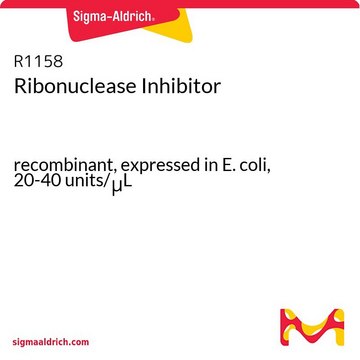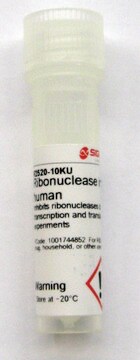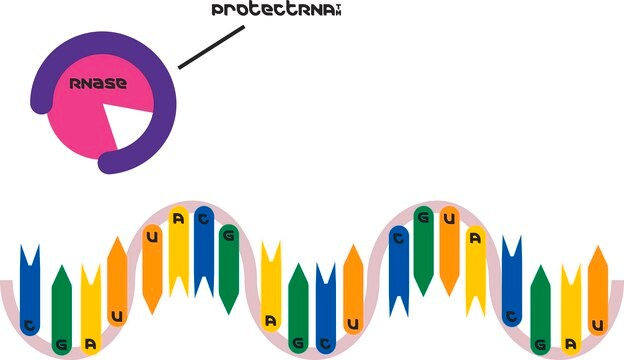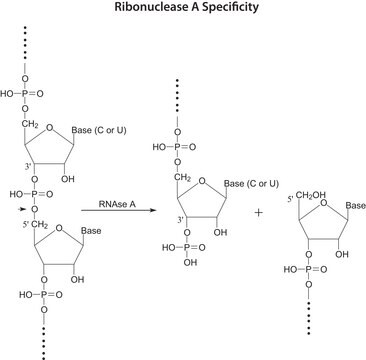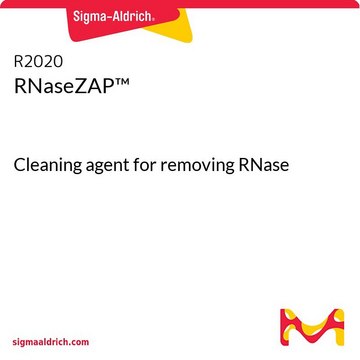556881
Ribonuclease Inhibitor, Human, Recombinant, E. coli
The Ribonuclease Inhibitor, Human, Recombinant, E. coli controls the biological activity of Ribonuclease. This small molecule/inhibitor is primarily used for Protease Inhibitors applications.
Sign Into View Organizational & Contract Pricing
All Photos(1)
About This Item
UNSPSC Code:
12352200
Recommended Products
Quality Level
form
liquid
specific activity
≥20,000 units/mL
manufacturer/tradename
Calbiochem®
storage condition
OK to freeze
foreign activity
Endonuclease and RNase, none detected
shipped in
wet ice
storage temp.
−20°C
General description
Recombinant, human ribonuclease inhibitor expressed in E. coli. Non-competitive inhibitor that inactivates RNase by non-covalent binding. Has been used to improve cDNA synthesis and in vitro RNA synthesis, increase yields of polysomes, and aid in the preparation of RNase-free antibodies. Inhibits RNases A, B, and C. Does not inhibit RNase T1 and S1 nuclease from Aspergillus.
Biochem/physiol Actions
Cell permeable: no
Primary Target
inactivates RNase
inactivates RNase
Product does not compete with ATP.
Reversible: no
Warning
Toxicity: Standard Handling (A)
Unit Definition
One unit is defined as the amount of material that will inhibit 50% of the activity of 5 ng of RNase A.
Physical form
In 50 mM KCl, 20 mM HEPES, 8 mM DTT, 50% glycerol.
Reconstitution
Maintain at -20°C. Avoid freezing solutions. Addition of DTT is recommended to maintain 8 mM level.
Other Notes
Saxena, S.K., et al. 1992. J. Biol. Chem. 267, 21982.
Lee, F.S., et al. 1989. Biochemistry 28, 225.
Lee, F.S., et al. 1989. Biochemistry 28, 225.
Legal Information
CALBIOCHEM is a registered trademark of Merck KGaA, Darmstadt, Germany
Storage Class Code
12 - Non Combustible Liquids
WGK
WGK 1
Flash Point(F)
Not applicable
Flash Point(C)
Not applicable
Certificates of Analysis (COA)
Search for Certificates of Analysis (COA) by entering the products Lot/Batch Number. Lot and Batch Numbers can be found on a product’s label following the words ‘Lot’ or ‘Batch’.
Already Own This Product?
Find documentation for the products that you have recently purchased in the Document Library.
Ihshan Akthar et al.
Reproduction (Cambridge, England) (2019-12-04)
We previously reported that sperm binding to cultured monolayers of bovine uterine epithelial cells induces an acute inflammatory response involving the Toll-like receptor (TLR2) signaling pathway. This response serves to clear the uterus of sperm and thereby prepares the endometrium
Rajendran Senthil Kumar et al.
Genomics, 112(2), 1464-1476 (2019-08-27)
Pieris rapae is a serious pest of brassicas worldwide. We performed de novo assembly of P. rapae transcriptome by next-generation sequencing and assembled approximately 65,727,422 clean paired-end reads into 32,118 unigenes, of which 13,585 were mapped to 255 pathways in
Maria-Alexandra Papadimitriou et al.
Journal of cancer research and clinical oncology, 145(12), 3075-3087 (2019-10-09)
Bladder cancer represents a major cause of malignancy-related morbidity and the most expensive per-patient-to-treat cancer, due to the lifelong surveillance of the patients. Accurate disease prognosis is essential in establishing personalized treatment decisions; yet optimum tools for precise risk stratification
Sabrina Bertin et al.
Archives of virology, 165(4), 937-946 (2020-03-19)
Watermelon mosaic virus (WMV; genus Potyvirus, family Potyviridae) is responsible for serious cucurbit yield losses worldwide. Different WMV genetic groups have been characterized so far. Among these, the "classical" (CL) group has been present in the Mediterranean basin for 40 years
Matthew G Costales et al.
Proceedings of the National Academy of Sciences of the United States of America, 117(5), 2406-2411 (2020-01-23)
As the area of small molecules interacting with RNA advances, general routes to provide bioactive compounds are needed as ligands can bind RNA avidly to sites that will not affect function. Small-molecule targeted RNA degradation will thus provide a general
Our team of scientists has experience in all areas of research including Life Science, Material Science, Chemical Synthesis, Chromatography, Analytical and many others.
Contact Technical Service